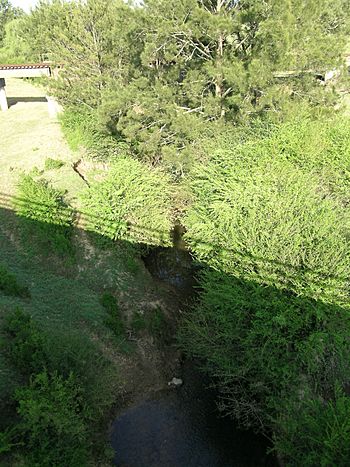Avon River (Mid-Coast Council) facts for kids
Quick facts for kids Avon River |
|
|---|---|

Avon River at Stratford
|
|
| Country | Australia |
| State | New South Wales |
| IBRA | NSW North Coast |
| District | Upper Hunter |
| Municipality | Mid-Coast Council |
| Physical characteristics | |
| Main source | Barrington Tops south of Carsonville 498 m (1,634 ft) |
| River mouth | confluence with the Gloucester River near Gloucester 86 m (282 ft) |
| Length | 42 km (26 mi) |
| Basin features | |
| River system | Manning River catchment |
| Tributaries |
|
The Avon River is a river in New South Wales, Australia. It's a perennial stream, meaning it flows all year round. The river is part of the larger Manning River system. You can find it in the Hunter Region, which is in the eastern part of New South Wales.
Where the Avon River Flows
The Avon River starts in the northern hills of the Barrington Tops. This area is south of a place called Carsonville. The river then flows mostly towards the north-east.
As it travels, five smaller streams, called tributaries, join the Avon River. These tributaries add more water to the river. The river drops about 412 metres (1,352 ft) over its 42 kilometres (26 mi) journey.
Finally, the Avon River meets the Gloucester River. This meeting point is called a confluence. It happens near the town of Gloucester. The Gloucester River then flows into the Manning River. The Manning River eventually reaches the Tasman Sea. It forms a small river delta near Taree.
Water and Weather
The area around the Avon River gets water from melting snow in spring. This helps keep the river flowing. The Gloucester district can get very hot in summer. However, it also gets a lot of rain, about 1,300 millimetres (51 in) each year.
Because of all the water from rain and melting snow, the Avon Valley can sometimes flood. These floods can be serious. They can even cut off roads and other ways to travel in the area.
River Health
Scientists have studied the water quality of the Avon River. In 2004, a study looked at samples from 1997. It found that the water quality was not very good. There were high levels of nutrients, which led to too much algae growing.
Also, in some parts of the river, especially downstream from Stratford, the riverbanks are eroding. This means the soil is washing away. Non-native plants have also started growing along the river. These issues have made the river less healthy.

